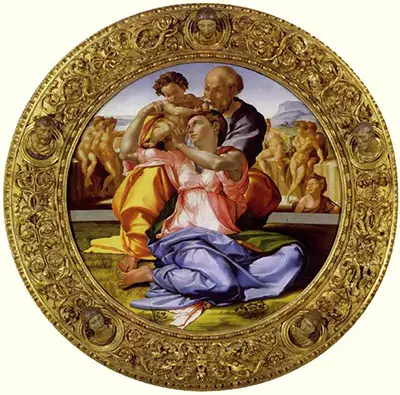The painting is the only painting that is anonymously attributed to Michelangelo and it is best known as Doni Tondo from the name of its buyer.
In the Florentine tradition, round shape was ordinarily used to celebrate the birth of a child. Currently, the painting is conserved in its original frame at the Uffizi in Florence. The frame is believed to be designed by Michelangelo.
It is interesting to note that the 2nd floor of the Uffizi Gallery is a floor dedicated to Michelangelo.
The Doni Tondo was painted after the sculpture of David and this clearly reflected in the colours that shape the volumes of the experience of Michelangelo as a sculptor. The panel predicts the works of Michelangelo in the ceiling of Sistine chapel.
Its role is clear in determining the rules of painting throughout the 16th century which initiated the period of mannerism. The use of colour in the Holy Family is exceptional. It is totally systematic with the bright colours which are on the Sistine Chapel ceiling recovered by the restoration of the 1980s.
The Virgin Mary takes us much of the Centre of the image making her the most prominent figure in the painting. Mary is sitting on the ground with no barrier between the ground and herself showing her connection with the earth. Saint Joseph has in a higher position in the painting compared to Mary.
Maybe to show that he is the head of the family or the protector. There has been some debate as to whether Mary is receiving the child from joseph or Joseph receiving the baby Jesus from Mary.
Saint John the Baptist is shown in the middle ground of the painting between the holy family and the background. Most Florentine works showing Mary and baby Jesus include him. There is a horizontal band between the foreground and john that acts as a separation.
There are nude figures in the background of the painting, on both sides, and is unclear if the nudes have a significance in the painting or they just part of the work. Behind the nude figures is a landscape of rocky hills. The Doni Tondo has an elegant wooden frame.
The frame is ornately curved and unusual with the five heads on it protruding three-dimensionally into space. The significance of the five heads on the frame, like the naked figures, are subject to speculation.
The Doni Tondo exemplifies a lot of the signature techniques Michelangelo put here and later in his larger pieces ad it is known to be the only time that Michelangelo painted without an assistant.
The contrast between the brighter and more hushed colours in the painting is extraordinary. Michelangelo used a shading design that gives an unfocused, softer background figures while ensuring that the primary figures are prominent and in the distinct element.
From an artistic point of view, the Doni Tondo laid the foundation of the mannerism technique. Mannerism was a style of painting that adopted strange and unnatural poses and lustrous colours to compose paintings. This makes the painting the most important as it started a trend of painting that only existed for a couple of decades.


